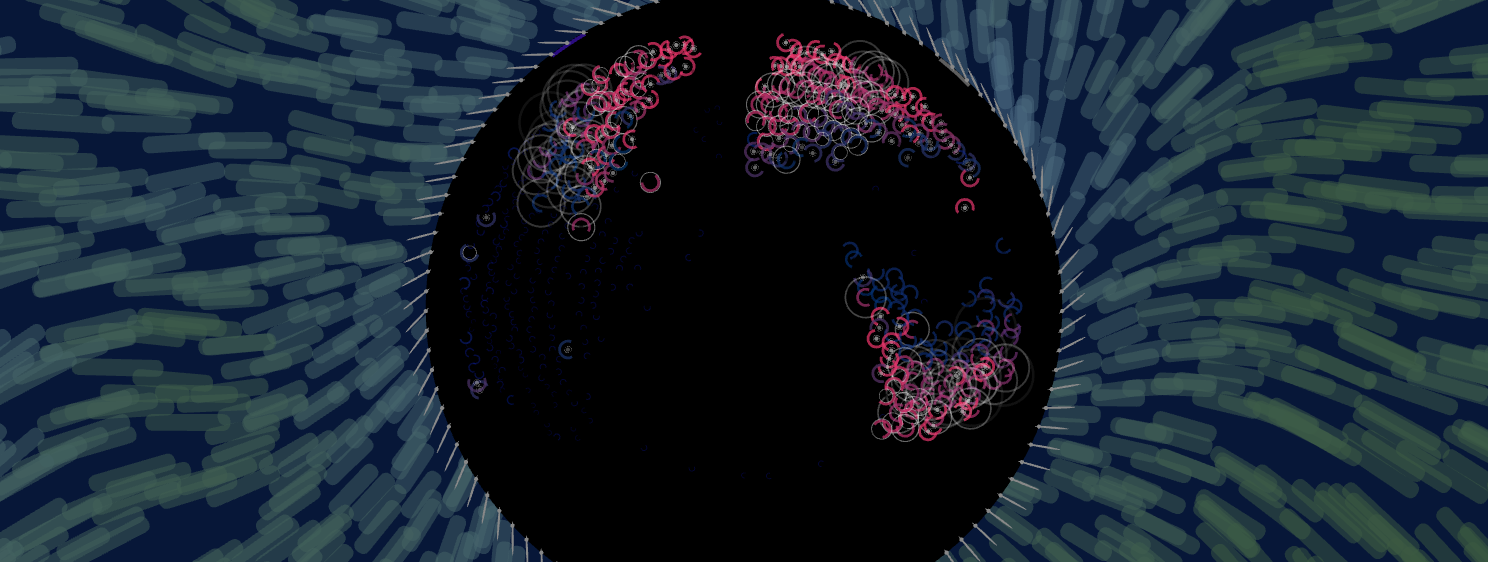If my passions were a Venn diagram, there would be three circles: coding, art, and brains. There is an open call for science related exhibitions at my local university’s arts centre, so I am submitting a digital work that incorporates some visual representations of firing neurons, in a simple simulation: right at the heart of my Venn diagram.
My untrained visual skills and coding skills are what they are, so this may get nowhere, but it has been fun to produce a work that hits the sweet spot for me. My piece, Equals Thought?, invites you to observe the intricate workings of a simple brain, and consider how these relate to some inner experience of the world.
To view this visualisation full screen, click here
Equals Thought? takes a very simple brain (a few hundred neurons with a few thousand connections) arranged with each neuron having dendrites that reach to some preceding neurons. At the outer edge, neurons connect to sensor cells that can detect changes in the imaginary world beyond the brain. Changes detected alter the level of excitation or inhibition on an individual dendrite. When a neuron sums up the excitation and inhibition, and that sum exceeds a threshold, the neuron fires. This creates an energy that can then be passed on as level of excitation or inhibition to other neurons, whose dendrites reach to this, newly triggered neuron.
There are so many shortcuts taken here compared with a biological neuron, but this is art reflecting science, not a pure model. It’s worth pointing out as well that this is not a depiction of artificial neural networks, as used in machine learning algorithms. I would have loved to crank up the number of neurons and connections – I think it could be spectacular, but there are limits to how many connections I can update and render in between frames as the image gets rendered to the screen.
So from conditions in the outside world, the brain responds with cascades of excitation and firing across the network of neurons.
The visual spectacle comes in how these shifting levels and states are depicted. There are three, each giving a different perspective on the action. First, the dendrites are shown, as direct connections between one neuron and another (in case you were asking the axons are not visually represented, the dendrite comes all the way to the preceding neuron). The colour of the dendrite indicates its level of excitement or inhibition in that instant, and the path shows the two neurons involved. Secondly, when the neuron fires, its body, effectively the Axon Hillock, illuminates briefly, and shows a little ripple as it loses its energy after firing. Because this can be very fleeting, I have included a third visualisation, a kind of glow that indicates how active a neuron is, with a slow fade, so you can see a history of activity in the brain.
So far these are pretty literal interpretations of a massively simplified brain made of massively simplified neurons. Thats the part anchored in science.
The artistic element comes in the spectacle of these cascades, visualised through the three manifestations described above: lit dendrites, firing neurons, and an afterglow of neuronal activity.
A wet machine or the seat of thought?
As you observe these different shifting perspectives on the inner world of a brain that responds to its environment, you could think of yourself as a neuroscientist with a tool that lets you accurately measure the instantaneous state of the brain and its neurons. You are simply observing a digital representation of a wet machine, with a set of predefined biological, chemical and electrical processes.
But you could equally consider how these cascades and states are a set of thoughts or experiences inside the brain.
What is the relationship between these states and the inner experience, if there is one?Who or what is experiencing it anyway?Can we ever map these two worlds, even in the simplest of brains?How complex must a brain become before we can envision more than a biochemical machine, and one that has some inner experience as a product?
I’ll leave you to watch and ponder.


Recent Comments